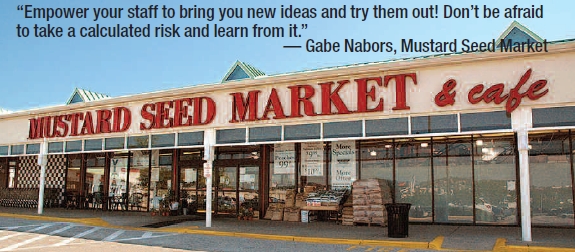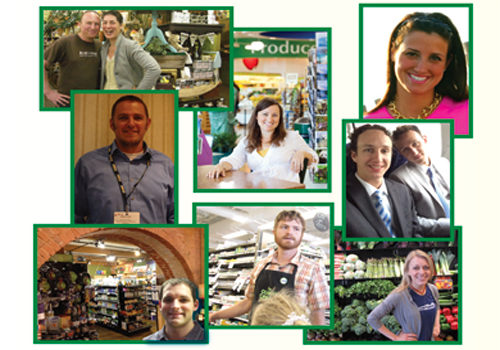Part Three of a Seven-Part Series on Natural Success Stories
There’s a transformation underway in the natural retailing community. After decades of strong leadership, many pioneering retailers are scaling back their duties or passing the reins of their stores to the next generation of retailers—some family members, others young entrepreneurs. At the same time, we’re seeing stores grow from the ground up under the guidance of young owners who are new to natural or retailing or both.
And, as Generations X and Y continue to come to the forefront as business leaders, here’s a look at their priorities and the changes they are bringing to the natural products industry as a whole.
A Family Affair
Some second-generation natural products retailers literally grew up in the industry. “Rainbow Blossom is 37 years old as a business. We’ve been in business longer than I’ve been alive,” says Summer Auerbach, second-generation owner of Rainbow Blossom Natural Food Markets, Louisville, KY. “We have current employees who have known me since I was a child.”
Her parents, the store’s cofounders Rob and Pumpkin Auerbach, brought their daughter to the store regularly after school; it was like her home away from home. “I would help customers or bag groceries or bag bulk...It felt like home,” says the younger Auerbach.
Similarly, Rory Eames, second-generation owner of Organic Market (formerly Cape Cod Natural Markets and Dennisport Natural Market) in Massachusetts, spent countless hours in the store her mother, Darby Ziruk, opened. Eames says her mother was the biggest influence on her as a retailer. “I watched my mother and grew up in the stores and saw how she built our company and how much she cared for our community and our stores. She went from a 600-ft2 store to 2,000-ft2 and 3,000-ft2 stores, and now we’re opening a 4,000-ft2 store in June.”
Auerbach had the leadership of her parents to look to, but when she was pressed into service around 2004 to lead the business (three locations and growing), times were tough and she knew she needed to do things a little differently if Rainbow Blossom was to survive. Not only was her father extremely ill—and too sick to devote himself to the business—but, Whole Foods Market and Wild Oats had come to town and were taking away some business.
“I had just finished business school [at Bentley University], but was not planning on coming back home,” says Auerbach. “It was a little bit of a strange transition. The staff was really deflated because of the competition we were facing. The store was in a lot of debt. People’s spirits were sort of crushed because my dad was so sick.”
And so, like many young retailers, Auerbach faced a very tough challenge: creating/recreating a natural products store in today’s competitive market with his/her own unique mark.
Nicholas Pascoe, co-owner of Bear Foods Natural Market & Cafe, Chelan, WA, stepped into such a situation when he purchased his store nearly six years ago (originally founded in the 1970s) with a specific goal for the end result: “to take it from what was classically known as the dusty old health food store—meaning it had a lot of the bulk herbs and spices and that type of thing—and turn it into something we believe is a good food store. A clean gourmet store.”
The task for him and his wife Teresa was easier said than done. Bulk herbs and foods were popular, and the community wasn’t immediately ready for changes. “Part of it was convincing the locals that this was a good way to go and that they would actually enjoy this journey. That was a significant challenge,” says Pascoe.
The pair chose to keep the cleaner bulk  products in the inventory because they appreciated that shoppers could save money by buying in bulk. “But, it needed to be good, clean products, so we shifted over to more organic, especially for at-risk GMO products, which is another big step,” says Pascoe. “We really took a very anti-GMO stance quite aggressively.” He and his wife have been active in the non-GMO movement, even testifying in the state Senate on GMO labeling issues.
products in the inventory because they appreciated that shoppers could save money by buying in bulk. “But, it needed to be good, clean products, so we shifted over to more organic, especially for at-risk GMO products, which is another big step,” says Pascoe. “We really took a very anti-GMO stance quite aggressively.” He and his wife have been active in the non-GMO movement, even testifying in the state Senate on GMO labeling issues.
In the end, this stance kept old shoppers coming in and brought new ones through the door. “What’s happened is that a lot of people who were supporting the older store have realized that through our efforts to maintain the non-GMO food supply, we’re actually advocating for their needs and really aggressively supporting the companies that have gone non-GMO. That’s given us a really significant market share in the area,” Pascoe explains.
Pascoe believes that his aggressive non-GMO stance resonates especially well with the young people in his community. “The youth are welcoming of new technologies when it comes to smart phone and tablets. But they are rejecting new technology as modified food…So, they’re becoming very big supporters of us as a result of our stance on that,” he believes.
In the end, Gabe Nabors, second-generation owner of Mustard Seed Market, in Ohio, says there are both positive and negative challenges to stepping into a leadership role. “When you come into a family business that is evolving and you’re the second generation, it’s about identifying the opportunities for creating a stronger culture,” he states. “I ask myself frequently, what can I do to make my team more effective leaders? How can I implement a fresh idea but still keep the building blocks from the original set of values that built this company?”
Abraham Nabors, also a second-generation owner of Mustard Seed Market, says one issue when shifting from one generation of leadership to the next is “The Founder’s Syndrome,” meaning that the business tends to revert back to how things have traditionally been done by the original founder. “This can cause some challenges for the next leadership, especially when they try to implement new initiatives,” he says.
It’s a delicate balance deciding what to change and what to keep. “You never want to scrap things that make up the identity of the business but you also don’t want to be locked into a situation that halts progress,” Abraham states. “It’s all about keeping the best parts the founding leadership has established and building on the strengths going forward.”
Community Interaction
Moving forward as a new leader, for many of this story’s interviewees, meant reaching out to the community in positive ways. In fact, becoming a community meeting place was one of the inspirations for Jonas Buehl and his wife Missy to open The Crunchy Grocer, Loveland, CO, in November 2013.
“One of the core foundations of the culture we were trying to create was a social gathering place for foodies,” says Buehl. “We wanted to get to the point where we were busy enough for shoppers to expect to see like-minded people in our store, people who embrace a healthier food culture and a living food culture. I wanted to see people running into each other in the aisles and stopping to talk.”
 Creating this hub for foodies was modeled after some “really cool, bustling co-ops we had seen that just had a great vibe,” he explains. And, getting shoppers involved in the store community has meant several unique initiatives from The Crunchy Grocer like opening with locavesting support, in which individuals invested money in the store in exchange for a return and a store discount so as to close a small funding gap. From there, the store kept the community involved by soliciting feedback for products on Facebook, hosting an opening celebration party, holding a holiday open house with local food and gift vendors, offering music performances, hosting wellness classes, holding a kids’ book launch party, making food donations to charity and more. The store even organized a “March Against Monsanto” event. All have helped establish an active, thriving store community.
Creating this hub for foodies was modeled after some “really cool, bustling co-ops we had seen that just had a great vibe,” he explains. And, getting shoppers involved in the store community has meant several unique initiatives from The Crunchy Grocer like opening with locavesting support, in which individuals invested money in the store in exchange for a return and a store discount so as to close a small funding gap. From there, the store kept the community involved by soliciting feedback for products on Facebook, hosting an opening celebration party, holding a holiday open house with local food and gift vendors, offering music performances, hosting wellness classes, holding a kids’ book launch party, making food donations to charity and more. The store even organized a “March Against Monsanto” event. All have helped establish an active, thriving store community.
Likewise, social interaction is key for store leaders who stepped into an existing store with an established community of shoppers.
When Eames became the key person at Organic Market about five years ago, she says, “one thing I did not want to change was the fact that we knew every customer by name. We really had a personal relationship with our community. We’re like a big family…We’re really lucky that we have such a great store culture.”
Meanwhile, Auerbach brought her family’s stores back to life by creating excitement for it through community events. “The first event I did was an alternative health fair, reaching out to natural practitioners in the community and having them host tabletop exhibits. I had never seen the staff so excited and happy. That launched a whole series of events like tasting fairs or educational events or things that even for one day would bring a whole influx of people into the store and create a lively environment,” she explains.
Abraham Nabors took a similar approach at Mustard Seed Market, by creating an educational lecture series in which he hosted more than 100 lectures and cooking classes annually. “Education is critical when you are selling highly specialized products,” he states. “Most of America didn’t grow up eating quinoa and chia seeds, so it’s important to share why they are wonderful food choices.”
Aside from in-person education, Auerbach wanted to be able to share her expertise and opinions with the masses in print and made herself readily available to the media. “Whether its Trader Joe’s or another competitor coming to town, we’ve never had an opening where reporters didn’t ask our opinions on that because we’re constantly sending out press releases and letters and communicating with them to let them know what we’re up to. That’s really helped,” says Auerbach.
Buehl, too, made himself available to newspaper reporters interested in covering his store.
Joel Patterson, owner of Nature’s Green Grocer Market & Café, Peterborough, NH, took a different approach to egaging the community: competitive pricing. This strategy was especially important for this retailer, since his store is located off the beaten path and needed to be a “destination” for shoppers.
“We have a rule in our pricing structure. If we get a discount, we pass it on… I’m not just in business to be in business. I really want to feed more people organically. And if that means we pass on a better price, and as a result we can feed people who might not otherwise be able to afford it, then I’m all for it,” Patterson states.
Another aspect of his pricing strategy is a generous loyalty program that is known for drawing in new shoppers and maintaining a thriving regular customer base. Says Patterson, “We give 3–5% back on everything you buy, depending on what you buy and our margin, as a green rewards cash back—redeemable $20 at a time. It’s not difficult. There are no coupons to print out. The cash doesn’t expire...We want to give back to shoppers. We want them to come back in again because there’s money waiting for them.”
Similarly, a smart promotions strategy was key for Gabe Nabors. He analyzed his store’s previous marketing initiatives and realized they had been targeting the same markets with similar promotions again and again. “I switched up both the promotions and the target markets we focused on,” Nabors states. “It paid off and gave us a bigger market share.”
Thus, the takeaway message is tomorrow’s retailers will do more than sell product. They will engage shoppers in new and exciting ways that will keep shoppers coming back for years to come.
Keeping it Fresh
Fresh food offerings were cited as an integral factor by most businesses included in this piece. For Patterson, it was the core of his business strategy. This culinarily trained retailer opened a natural products store in 2008 with the goal of having a business where fresh foods reigned supreme and shoppers came in multiple times per week to buy food. “That was my vision and my goal. I wanted more than one freezer door of meat. I wanted a huge selection of fresh meats and fresh seafood and everything necessary to build your menu item in all organic and fresh produce and keeping with that theme of one-stop shop,” he states.
|
Next-Generation Stores Several of the young retailers interviewed for this piece oversaw renovations or the opening of new stores. Two business are currently erecting new locations, which are due to open this summer/fall. |
|

|
|
| Organic Market’s third location, coming to Mashpee, MA | |
|
Rory Eames, second-generation owner of Organic Market (formerly Cape Cod Natural Markets and Dennisport Natural Market) in Massachusetts, is creating a third location in Mashpee, MA, boasting 4,000 square feet. “We’re currently in older buildings and have to work with the spaces we have,” she says, adding that the third location is a different ballgame. “To be involved in the design and doing everything from the ground up has been really amazing.” Like the current two stores, nothing will be allowed on the shelves unless it’s organic or non-GMO verified. The new store will be home to the largest organic produce department in Cape Cod as well as food service offerings like an organic juice and smoothie bar, prepared salads and sandwiches, hot food, organic meats and specialty cheeses, fresh artisan breads and more. Of course, the store will also house full grocery, supplements and personal care departments. |
|

|
|
| Rendering of Penn Herb Co.’s rebuilt store in Philadelphia, PA, to reopen this fall. | |
|
Meanwhile, Penn Herb Company, Philadelphia, PA, broke ground on a brand new building that has a beautiful store on the bottom floor and 14 boutique apartments on the top two floors. The store is slated to be larger than its previous location, and will house more products, a tea bar, a smoothie bar, and facilities for lectures and educational events. Karen Page, national sales manager of Penn Herb, adds that the store will be equipped with free-standing kiosks with which shoppers can interact and look up questions about various topics. “We’re really looking forward to developing a place where our core customers that have been loyal to our store forever feel comfortable and can still get their traditional remedies, and at the same time attract new customers who can become acquainted with our natural product offerings in a way that’s very hands on,” she states. |
Such shopping is appealing to shoppers beyond your traditional organic shopper. “Whether it’s people who have been shopping naturally or organically for years or people just coming into it with new eyes and a new mindset, people want to buy their fresh items—meat, produce, dairy—in a store like ours,” he believes. “More and more, they are trending away from going to a store once per week and filling up a big cart. When you come in and shop naturally and organically, you can’t buy everything you need for a week because it won’t last that long. It’s not laden with chemicals.”
He adds, “In our store, people are shopping at minimum every three days. And we see a lot of our customers every day. It creates sort of that Old World community feel because everybody’s coming in on a regular basis to get their fresh food items.”
Michael Anderson, vice president of The Sunspot Natural Market, Kokomo, IN and West Lafayette, IN, also feels that fresh foods have helped draw in shoppers that hadn’t previously frequented the business. “Within the last two to three years, our grab-and-go section has really taken off at both of our stores,” he states. “We’ve made a concerted effort to partner with local produce and dairy vendors and egg farmers to offer foods made with local, natural ingredients.”
As a result, the store sees people come in looking for a quick healthy lunch, for instance, that isn’t fast food. “Our Kokomo location has been interesting. We’re a big factory town and we’re seeing a lot of those workers come into the store as well,” he adds.
“That’s a big trend in our industry,” adds Patterson. “It’s not just people who care about organic or who have dietary needs. There are also people who just want it to taste good. And food is going to taste better with better ingredients without all the junk and chemicals in it. So, we get foodies that come in regularly.”
Fresh food offerings and food service are key priorities for Eames, too. She states, “We added a juice bar last year, which has been a huge success. We’re really happy with it. And we’re adding more food service all the time.”
She believes fresh food is especially a draw to younger shoppers and families. “They want something easy, something fun that the kids can go pick out like a smoothie or a vegan cookie. It’s really great to offer that to people.”
In agreement is Gabe Nabors, who says convenience items are key for younger shoppers. “The younger shopper loves grab-and-go foods. Samples are always a plus, too,” he says.
“I see how many younger people and families are shopping in natural products stores…it’s been a revelation,” says Karen Page, national sales manager at the corporate offices of Penn Herb Company, Philadelphia, PA. She explains that their new store, which is being rebuilt on its original site, is located in what has become a major enclave of young professionals, students and artists. “We want to appeal to those who frequent and live in the area. While many young people like to shop online, most also enjoy social engagement. Our planned Tea Bar and an area for health discussions will contribute greatly to a sense of community in the new store.”
She says participating in a local farmer’s market a while back really appealed to them. “I was able to purchase apple cider from the farmer next to me and show people that they could buy mulling spices from us, and make a great warm beverage,” she states.
Eames says, even with strong retirement-based and summer-only communities in Cape Cod, her stores are a draw for young people and the fresh foods are helping to pack them in. “It’s really been great to see how many weekly and daily grocery shoppers are under the age of 40 and live in the area. Fifteen years ago, that may not have been the case. We’re definitely becoming more relevant in our community,” Eames states.
The new location of Organic Market will have fresh food offerings to bring in shoppers and compete with larger stores. “I couldn’t even imagine opening a new store without having a juice bar and food service because it’s such a big draw for people. It’s really important. And, it’s what all the big competitors are doing, so you have to,” she says.
Pascoe is also a believer in what prepared foods can do for a business and the community. His store added a creperie to bring extra business to the store, and did so while staying true to the store’s core beliefs. “We made it non-allergenic and non-GMO. It’s wheat, gluten, dairy, egg and soy free because of the ever-increasing demand coming from the non-allergenic sector. But also, that ties directly in with the GMOs side, which is where a lot of the allergies come from in the first place,” says Pascoe. “We’re supplying people who have become allergic, and to people who either don’t want to become allergic or just can’t eat anything else or just want to avoid the highly processed food.”
Bringing in the Technology
Many young retailers inherited stores that were lacking on the technology front. Auerbach reminiscences about the pen-and-paper ordering system from when she started. Faxing in orders was an advancement!
“I remember my dad saying, ‘Oh, it’s not worth it to do virtual inventory. You drop a yogurt, and then what are you going to do?’ Technology makes things easier. As we have grown as a company, it’s also important to grow our operations,” says Auerbach.
Her store is now much more “techie,” thanks to its ScanGenius system (from Living Naturally) that allows the store to download catalogs, scan products, and upload ordering information to a computer where it’s edited and submitted. “Now, we’re transitioning to a point-of-sale integrated ordering system where we have implemented virtual inventory. So now, we can do more of an automated ordering process where we’re just double-checking everything,” she explains.
Anderson was in a similar boat. He had worked at his aunt’s store as a teen, and returned in 2007 after graduating from college with a computer engineering degree. The degree helped him reassess where the store stood from a technology standpoint and make suggestions for some much-needed updates. “We had been very old school in the way we had been doing orders and a lot of our processes. We didn’t even have a point-of-sale system,” he states.
The staff handled the changes very well, says Anderson. “Everything incorporated really well.”
Pascoe, too, felt one of the biggest problems with the store he purchased was lack of technology. “The previous owner had actually put in a point-of-sale system, but none of the buyers had their own computers or e-mail accounts. They didn’t have cordless phones. There were no wireless stations to do inventory,” he recalls.
Pascoe felt updating the store would allow employees to work more efficiently, so he made it a focus to bring everything up to scratch.
“In my mind, from my years doing business consulting and as a business owner, you cannot serve our customer base correctly and run a good business without a technology component,” Patterson believes.
For five of its six years in business, his store has used Catapult tools from ECRS, which “help our business and our customers by giving us the ability to buy better and to offer better prices.”
Patterson suggests stores putting in such a system take the time to learn it well so it can be used to its greatest potential. “It pains me when I see others in the industry with a POS system and they say they don’t know how to use the features,” he states. “We use our system to the fullest extent.”
Getting Online
Alerting shoppers about sales, new products, events and promotions is less about paper these days, too. Many interviewees cited social media as a critical tool to use.
Buehl says Facebook was the first major way his store reached out to the community; before opening its doors, they had generated 2,700 Facebook fans.
“We’ve done less print and are focusing our advertising dollars on online and updating our Facebook page everyday,” adds Eames.
Likewise, Auerbach says her business uses social media to connect and tell its story to consumers. Each of Rainbow Blossom’s five stores has a social media captain to work on social media, and a social media manager that coordinates the efforts for all locations.
Anderson’s store takes a similar approach with Facebook to help maintain the store’s voice online. “We don’t allow a lot of people to moderate or administer the content that goes on social media. One main person does it, and a couple of others approve things,” he states. “This way, there’s not the potential for any damaging material to get out there.”
Both Nabors feel that making store information accessible on mobile devices is vastly important for reaching out to shoppers in today’s technology-driven world. Stated Abraham, “It’s important to keep up on the trends and follow through with implementing the changes that reflect the trends of younger shoppers. Everything is going digital and mobile these days, so a smartphone app or a mobile friendly Web site is key.”
Support Network
Nearly all of the retailers interviewed for this piece make use of an important support network to ensure their stores are the best they can be.
Auerbach felt the employees at her store—some of which knew her practically her entire life—held the door open while she passed through into a leadership role. “Some of the people who had been there for a long time really lifted me up and pushed me into a leadership position…They took me to tradeshows and taught me their buying strategies. They were these memory banks that helped us move forward.”
Page says her store realizes some of its key personnel are industry veterans and now is the time to start training some younger, dedicated staff members to be leaders as they advance in the organization. She states, “We want young employees to feel supported so they can do their jobs without feeling overwhelmed…We’ve been very grassroots since our beginning, and while maintaining our identity we’re also developing systems as we continue to grow to help manage that growth.”
Outside the store, retailers are making good use of their trade associations. Several retailers said the Independent Natural Food Retailers Association (INFRA), for instance, offers a wonderful support network of which they take advantage regularly.
“Joining INFRA has been one of the best decisions we’ve made as a business,” says Eames. “The support that you get from your peers has been so amazing and so encouraging. There’s always somebody who has been doing it longer, better or in a bigger area that you can turn to and ask for help with a problem.”
Eames and Auerbach spoke of using an INFRA-email group to post questions and get candid feedback from other retailers nationwide. Members use the list serve to ask about everything from implementing discounts to payroll issues.
“There’s something that’s truly invaluable about being able to interact and learn from people that are doing the exact same types of things that you are, but in a noncompetitive setting,” says Auerbach. “It would be hard to put a value on what I’ve gotten from INFRA. I’ve generated so many different ideas over the years, just from hearing what other people are doing. I think it’s the type of thing everyone should make time for.”
Meanwhile, Pascoe highlights the important role young retailers can play in supporting efforts like the Natural Products Association (NPA)’s annual Lobby Day in Washington, D.C. “Teresa and I annually travel to D.C. for NPA’s Lobby Day, and we get to meet with our state legislators so we can talk about these kinds of issues. It’s something we do year in and year out.” Pascoe also serves as the president of the NPA Northwest Board of Directors.
Anderson, who serves on NPA Midwest’s board, says being active in the group and attending Lobby Day has “really given me a sense for how things work. You learn what contacts to make so that when you do have issues that come up or there are threatening bills that are proposed, you know who to contact. It’s been a tremendous asset having access to all this knowledge.” WF
Published in WholeFoods Magazine, June 2014










